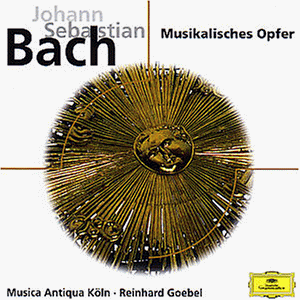|
|
|
01 |
Ricercar a 3 (Cembalo) |
|
|
|
05:45 |
|
|
02 |
Canon 1 a 2 cancrizans (Violine 1/2) |
|
|
|
00:51 |
|
|
03 |
Canon 2 a 2 Violini unisono (Violine 1 / 2 Viola da Gamba / Cembalo) |
|
|
|
00:47 |
|
|
04 |
Canon 3 per Motum contrarium |
|
|
|
00:33 |
|
|
05 |
Canon 4 a 2 per Augmentationem |
|
|
|
02:45 |
|
|
06 |
Canon 5 a 2 per Tonos |
|
|
|
02:38 |
|
|
07 |
Fuga canonica in Epidiapente |
|
|
|
02:08 |
|
|
08 |
Canon perpetuus super Thema Regium |
|
|
|
01:02 |
|
|
09 |
Canon perpetuus |
|
|
|
02:18 |
|
|
10 |
Canon a 2 (Cembalo) |
|
|
|
01:41 |
|
|
11 |
Canona a 4 (Violine 1 / 2 Cembalo) |
|
|
|
01:57 |
|
|
12 |
Sonata sopr'll Sogetto Reale 1. Largo |
|
|
|
06:00 |
|
|
13 |
Sonata sopr'll Sogetto Reale 2. Allegro |
|
|
|
06:03 |
|
|
14 |
Sonata sopr'll Sogetto Reale 3. Andante |
|
|
|
02:47 |
|
|
15 |
Sonata sopr'll Sogetto Reale 4. Allegor |
|
|
|
03:15 |
|
|
16 |
Ricercar a 6 (Cembalo) |
|
|
|
07:32 |
|
|
17 |
Sonate Nr. 2 Es-Dur BWV 1031 1. Allegro moderato |
|
|
|
03:29 |
|
|
18 |
Sonate Nr. 2 Es-Dur BWV 1031 2. Siciliano |
|
|
|
01:56 |
|
|
19 |
Sonate Nr. 2 Es-Dur BWV 1031 3. Allegor |
|
|
|
04:22 |
|
|
20 |
Sonate Nr. 2 E-Dur BWV 1035 1, Adagio ma non troppo |
|
|
|
02:42 |
|
|
21 |
Sonate Nr. 2 E-Dur BWV 1035 2. Allegor |
|
|
|
03:26 |
|
|
22 |
Sonate Nr. 2 E-Dur BWV 1035 3. Siciliano |
|
|
|
03:06 |
|
|
23 |
Sonate Nr. 2 E-Dur BWV 1035 4. Allegro assai |
|
|
|
03:05 |
|
|
|
| Country |
Germany |
| Cat. Number |
469 039-2 |
| UPC (Barcode) |
028946903926 |
| Packaging |
Jewel Case |
| Spars |
DDD |
| Sound |
Stereo |
|
|
| Conductor |
Reinhard Goebel |
|
Musica Antiqua Koln Deutsche Grammophon polydor International GmbH, Hamburg 469 039 -2 469 039 - 2
Musica Antiqua Ko"ln
Musica Antiqua Ko"ln was founded in 1973 by Reinhard Goebel, with fellow musicians from Ko"ln Conservatory.
Born in Siegen in Westphalia, Germany, on 31 July 1952, Reinhard Goebel began to study the violin at the age of twelve. At seventeen, he entered into the violin class of Franzjosef Maier, a member of Collegium Aureum, at Ko"ln Conservatory. He followed his studies in Essen under the direction of Saschko Gawriloff, a musician specialized in contemporary music, and in the Low Countries under Marie Leonhardt, who trained him on the Baroque violin. His immense knowledge of Baroque music and culture was built during his musicological studies at Cologne University. In an interview for the Spanish magazine Goldberg, he considers himself "merely a craftsman whose aim is to give an optimum performance of chamber music composed for stringed instruments between 1600 and 1750."
The very distinctive style of Musica Antiqua Ko"ln is clear since its first recordings: fast tempi, avoidance of vibrato, strong dynamic accents on the main beats and the messa di voce which has been a model for many Baroque ensembles. In a recent interview for the French magazine Diapason, Reinhard Goebel says that his German playing technique is based on Quantz and Pisendel, his ensemble searching for an intense and male sound in which the rhythmic impact of articulations express the common desire of his musicians for perfection, this associated with the search for absolute tuning and the use of the right instruments.
The career of the group can be divided into four generations, with some overlapping. The first generation of Musica Antiqua Ko"ln was a chamber group, with a strong bias toward German and French music. Bach's Musical Offering and Chamber Music records, and French Baroque Concerts are highlights of this time. The second generation was formed around an orchestra at the beginning of the eighties. Telemann's Wassermusik, Bach's Ouvertures and Brandenburg Concertos are among the best. The third generation was mainly an orchestra centered on Dresden orchestral repertory, and according to Reinhard Goebel himself, it happened because he could not play due to the laming of his left hand after recording Biber's Mystery Sonatas in 1990. The two Heinichen recordings have made a great stir in the small Baroque world and beyond. After ten or so years playing as a left-handed player, "the best second violinist in the world" plays right-handed again, and from Biber's Harmonia-artificioso ariosa, the fourth generation will concentrate on German chamber music of the second half of the XVII century, the repertory that Reinhard Goebel thinks he does best. In fact, the recent Charpentier recording is the last of Musica Antiqua Ko"ln as an orchestra.
The following list was originally developed by Maurizio Frigeni, who listed all the recordings sorted by release date and with links to detailed contents files. Only original recordings were taken into account here, but in the accompanying file he has usually given some indications about available reissues. I have been undertaken a revision since 2004.
Eduardo Kickhofel
kickhofel@hotmail.com
